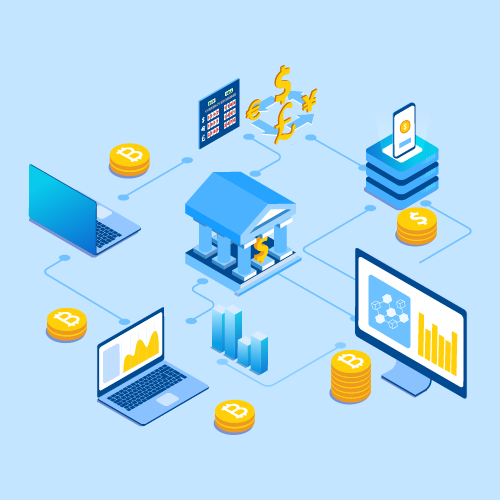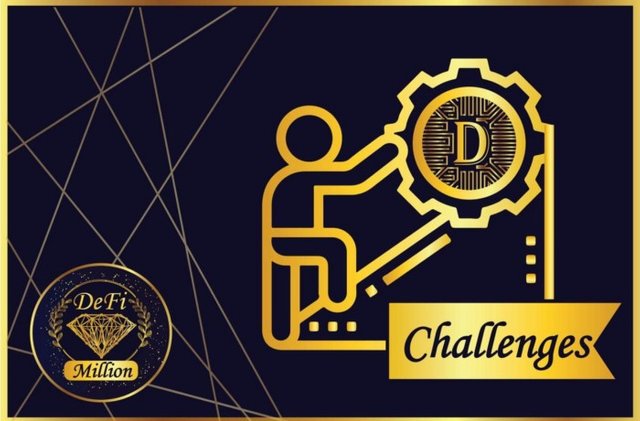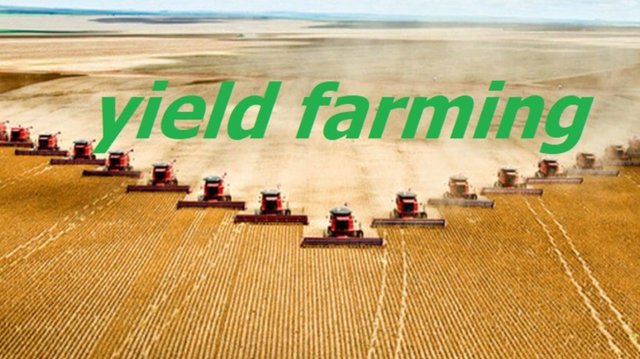Steemit Crypto Academy Homework Post Week 7 For @gbenga: Introduction To Defi And Yield Farming
Introduction
In short, decentralized finance is an idea where financial goods are available on a public decentralized blockchain system making them open to anyone to use rather than going through a means like banks/brokerages. Unlike a bank or brokerage account, a government-issued ID, social security number, or proof of address are not obligatory to use DeFi. More uniquely, DeFi refers to a system where software written on blockchains makes it possible for customers to unite to one another or with a surely software-based agent rather than a firm or custom facilitating a transaction.
Several technologies and protocols are used to attain the goal of decentralization. An example is, a decentralized system can include of a mix of open-source technologies, blockchain, and established software. Sharp deals that automate agreement terms between customers make these financial goods possible. Unconcerned of the technology used, DeFi systems are planned to remove negotiators between transacting parties.
What is DeFi?
The use of technology in financial amenities is not new. Most deals at banks are mastered with the help of technology nowadays. Although, the role of technology is limited to being a facilitator of such deals. Firms still have to contend with sailing the legalese of jurisdictions, challenging financial markets, and different standards to make a business possible. With its plenty of common software protocols and public blockchains to construct them on, DeFi places technology at the front and center of deals in the financial services construction.
DeFi is normally placed in the area of blockchain and cryptocurrencies. But its capacity is much wider. To understand the thought channels that led to the development of decentralized finance, it is good to understand the present state of the finance ecosystem.
Commercial prosperity/hardship emit outwards from hubs to spokes and towards the rest of the worldwide economy. This model of connection is repeated in the work of worldwide financial firm’s corporations. They have headquarters in hubs and local branches, partnerships and investments across the world. The sprawl of their action means that the organization itself is concern to a phalanx of laws and regulations in each of its financial powers. Their reach has made such organizations systemically good to maintain the world economy’s equilibrium and necessary to keep or manufacture new financial services infrastructure.
While this model operated well in the last century, the financial disaster and, subsequently, the Great Recession showed the flaw in this planning. The balance sheet challenges for a couple of large financial firms yielded a domino effect of tumbling economies and, subsequently, the onset of the world recession.
What Are the Components of DeFi?
At a broad level, the units of DeFi are equal as those for existing financial ecosystems, meaning they need stable currencies and a wide variety of use cases. DeFi units take the form of stablecoins and services like crypto trades and lending services. Clever contracts enhance the framework for the working of DeFi software because they encode the terms and projects needed for the working of these services. An example is, a smart deal code have certain code that establishes the exact terms and conditions of a loan between individuals. If certain terms or conditions are not met security could be close down. All of this is done through certain code rather than a bank manually doing this process.
All parts of a decentralized finance system is associated to a software stack. Each layer’s parts are meant to undergo a specific function in the building of a DeFi system. Composability is a defining feature of the stack because the parts belonging to each layer can be collected together to fashion a DeFi application.
Below are the three layers that contain the DeFi stack.
Settlement Layer: The settlement layer is also known as Layer 0 because it is the base layer upon which other DeFi deals are built. It contains a public blockchain and its native digital cryptocurrency. Deals occurring on DeFi software’s are settled using this currency, which may or may not be deal in public markets. Example of settlement layer is Ethereum and its native token ether (ETH) that is traded at crypto meetings.
Protocol Layer: Software protocols are levels and rules written to govern certain tasks. In a similar to real-world organizations, this would be a set of concepts and rules that all participants concerning to a given organization have agreed to follow as a pre-requisite to working in the organization. DeFi protocols are interworkable, meaning they can be used by several entities at the same time to construct a service. The protocol layer provides forign exchange to the DeFi ecosystem. Example of a DeFi protocol is Synthetix, a derivatives dealing protocol on Ethereum. It is used to create synthetic forms of real-world belongings.
Application Layer: As the name implies, the application layer is where consumer-facing applications stay. These applications abstract basic protocols into simple consumer-focused services. Most ordinary applications in the cryptocurrency ecosystem, such as decentralized cryptocurrency trading and lending services, stay on this layer.
The Current State of DeFi
Decentralized finance is still at the beginning phase of its evolution. The overall value locked in DeFi agreements is over $41 billion, as of March 20211. The overall value locked is measured by multiplying the number of tokens in the protocol and their value in USD. But the overall figure for DeFi may sound sizeable, it is good to remember that it is fantastic since many DeFi tokens lack sufficient foreign exchange and volume to deal in crypto markets.
The DeFi ecosystem is still riddled with constructional problems. Scams also abound in the quick-evolving DeFi construction. DeFi “Rug Pulls,” in which hackers clear a protocol of monies and stakeholders are unable to trade, are usual, though there are well-established protocols that can be used to minimize this risk significantly.
The open and relatively issued nature of the decentralized finance ecosystem might also have challenges to existing financial ruling. Present laws were created based on the idea of separate financial powers, each with its own set of rules and regulation. DeFi’s borderless transaction extent presents good questions for this type of regulation.
Clever deals are another area of concern for DeFi opration. Apart from Bitcoin's success, DeFi is the clearest example of the “code is law” thesis, where law is term as a set of rules and they are stated and enforced through fixed code. The clever contract’s algorithm is encoded with the required constructs and terms of use to conduct agreements between two sides. Although, software systems can fail due to a wide couple of factors.
What challenges does DeFi face?
Poor performance: Blockchains are naturally slower than their centralized complement, and this translates to the apps created on top of them. The creaters of DeFi apps need to take these boundaries into account and optimize their goods accordingly.
High risk of user error: DeFi apps transfer the control from the negotiator to the user. This can be a bad aspect for many. Creating goods that reduce the risk of user error is a particularly hard challenge when the goods are deployed on top of fixed blockchains.
Bad user experience: Currently, using DeFi apps needs more effort on the user’s part. For DeFi apps to be a core thing of the world financial system, they must give a rigid benefit that incentivizes users to shift over from the local system.
Advantages of DeFi?
Customary finance relies on organizations like banks to act as negotiator, and courts to give arbitration.
DeFi apps do not demand any negotiators/arbitrators. The code states the resolution of every likely dispute, and the users keep control over their money at all times. This limits the costs involving with giving and using these goods and allows for a more frictionless financial system.
So far as the frameworks for DeFi apps can be manufactured in advance, deploying one becomes much less complex and much more secure.
Yield Farming
Yield farming involves making more crypto with the crypto you are having. It includes loaning yours to others through the work of computer programs known as clever contracts. In getting back your service, you earn charges in the form of crypto.
Simple enough,
Yield farmers will use very complex ways. They move their cryptos around all the time between several loaning market zones to limit their returns. They will also be very secret about the best yield farming ways. Why? The more individuals gets to know about a way, the less effective it may become. The wild west of Decentralized Finance (DeFi) is Yield farming, where farmers challenge to get a possibility to farm the best crops.
How Yield Farming works
The initial step in yield farming consist of bringing together money to a liquidity pool, which are necessary clever deals that contain money. These pools power a market zone where customers can trade, lend or borrow tokens. Once you have bring together your funds to a pool, you have suitably become a liquidity provider.
In getting back for locking up your discover in the pool, you will be rewarded with charges taken from the basic DeFi platform. Be aware that investing in ETH itself, for an example, is not considered as yield farming. Instead, giving out ETH on a decentralized non-custodial funds market protocol like Aave, then getting a reward, is yield farming.
Reward tokens can be saved in liquidity pools, and it is a normal practice for people to move their money between several protocols to go for higher yields.
Yield farmers are usually very experienced with the Ethereum system and its technicalities and will move their moneies around to different DeFi sites in order to gaint the best returns.
Which projects are involved?
There are numerous of DeFi projects right now involved in yield farming. The largest right now in terms of use locked into clever deals is Aave, a project that let customers to lend and borrow a number of cryptocurrencies.
Follow up is yearn.finance, which works to shift customers’ monies between several lending and liquidity protocols to get the top interest rates.
And there is Compound, a DeFi site that let people to get money on the crypto they deposit.
The future of yield farming
It is virtually not able to accurately tell the future in such a volatile space. The overall consensus, although, is that the profitable bubble is likely to break out at some point.
Right now levels of hype and assumptions could likely place too much strain on the system, and cause crisis with crowding. Any arising price rectifying could result in some farmers being not able to liquidate their belongings, which could have a hit up effect on the general confidence in yield farming.
Conclusion
Decentralized Finance is based on building financial services different from the customary financial and political system. This would enable for a more open financial system and could potentially stop models of discrimination all over the world.
While a tempting idea, not everything interests from decentralization. Getting the use cases that are most acceptable for the features of blockchains is needed in building a useful stack of open financial goods.
If accomplished, DeFi will take power from many centralized organizations and put it in the hands of the open-source community and the individual. Whether that will establish a more efficient financial system will be marked once DeFi is ready for normal adoption.
Currently yield farming is still at high-risk, high-reward habit that might be value pursuing, as long as the required study and risk judgements have been moved out in advance
@steemcurator01
@steemcurator02
@steemitblog
@gbenga
Thank you very much for going through.



Thanks for being a part of my class and for participating in this week's assignment. I hope you learned from the class as the aim of the school is to teach and allow people to learn alongside.
Remark
Copying and posting all or any part of another author's article without quoting and properly referencing them is referred to as plagiarism and plagiarism is not welcomed on Steemit as it doesn't give Steemit a good SEO rating. I found similar content of your post in another article that existed before yours.
Your post
Similar Content
Source: https://academy.binance.com/en/articles/the-complete-beginners-guide-to-decentralized-finance-defi